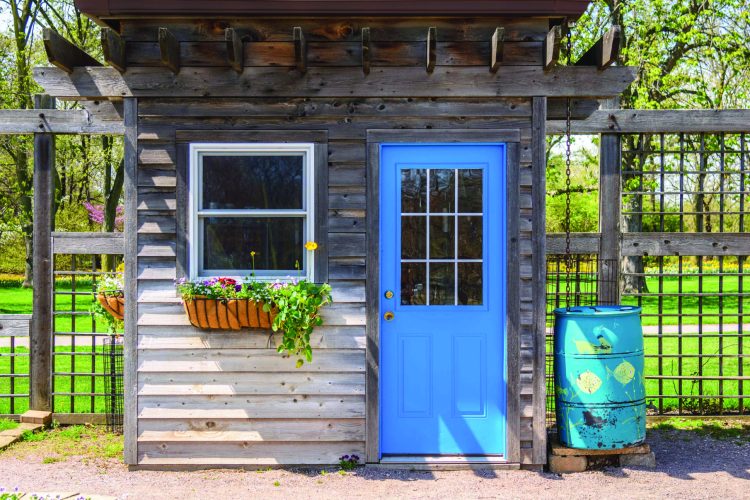By MetroCreative
From a kitchen pantry clean out to a custom shed build, there are simple, affordable home projects that will quickly make a living space feel larger and more organized.
The Kitchen Pantry
Clean it out. Dump the seven-year-old pouches of paprika, leaking molasses bottles and tins of weird, gourmet salt flavors. If the product hasn’t been used since the one time it was needed, it probably doesn’t taste that good anymore.
Maximize vertical storage. Utilizing vertical areas can help increase storage capacity. Build in extra nooks by investing in under-shelf storage baskets. These baskets can instantly create designated areas for different types of ingredients. Homeowners also can look for ways to use the inside of cabinet doors or add extra shelves on walls or in eaves.
Consider your needs. Figure out which items you would like to store in the pantry and then shop for corresponding storage systems. For example, storage solutions may feature wine bottle racks, baskets for potatoes and other produce, shelving for small appliances, and even pull out racks for baking pans or cutting boards.
Use clear storage. Put ingredients in clear, airtight containers of similar dimensions so that you can easily find items you need. Transfer bulky items, like cereals and baking supplies, to storage containers for uniformity.
Store bulk items elsewhere. Bulk shopping can be cost-efficient, but bulk items can quickly eat up real estate in the pantry. Designate another area for non-perishable bulk products, like paper goods or canned items, such as in a garage or utility room.
Pull out drawers are convenient. Pull-out drawers can reduce the need to seek and reach for items. These drawers conveniently roll out so items in the back can be accessed without disturbing foods in the front. Drawers can be custom built for any pantry space.
Make it accessible. Think about who will be taking items from the pantry. Put children’s snacks on the bottom pantry shelf where they can reach them, and then organize other shelves for adults in the home.
The Laundry Room
Laundry Butler for You, a wash, dry and fold service, says the average household washes 50 pounds of laundry a week and 6,000 articles of clothing every year. Families with children at home are doing laundry most often, and those with pets may find there is ample laundry to wash as well.
Assess your equipment. If your appliances are aging, a laundry room renovation can start with an investment in new appliances. New models have large capacity loads, tend to be energy-efficient and could have innovative features that help fit with your laundry lifestyle. Purchasing front-loading models also can free up design space, as you can install a counter directly above the units, saving room for other items like drying racks.
Figure out your room needs. A laundry room need not be limited to laundry only. Many homeowners make large laundry rooms catch-all spaces that can serve as utility or mud rooms, pantry overflows, or off-season storage areas. Consider the functions you want the room to serve and include those ideas in your designs.
Think about a utility sink. Many washing machines drain out directly to waste pipes in the floor or wall, but you also can opt to have them empty into a utility sink. This sink also provides a convenient place to hand-wash items, clean tools or paintbrushes, or store items that perhaps you do not want to bring into a bathroom or kitchen sink.
Include some flair. This utilitarian space need not be boring or bereft of design elements. Mirror your home’s style in the laundry room, and include wall hangings, plants, accent items, and even task lighting. Play up certain features with a bold floor tile or brightly colored walls.
The Not-for-Storage Shed
Get one. Extending your home’s living space by transforming a shed is easier and cheaper to do than a home addition. Check first with your local planning department in order to comply with local codes and guidelines then decide whether this will be a DIY project from the ground up or whether a prefabricated shed will best meet your needs. Prefab sheds of all sizes are now widely available at garden centers, hardware and home stores in a variety of architectural styles, from traditional to contemporary.
Add electricity. Wiring the shed is a key step to making it an auxiliary living space, and it doesn’t have to be all practical. “Homeowners are adding electricity to backyard sheds and using decorative interior lighting to make a statement, just as lighting would be used in the interiors of a home,” says Jennifer Kis, director of marketing communications for Progress Lighting.
Consider the design. Choose a shed style that complements your home. You may also want to match certain architectural features, like arched doorways or dormers.
Invest in quality materials. Spending a little more and using quality materials can ensure it lasts long enough to be cost-effective. The right materials will be resistant to splitting, cracking, decay, and insect damage.
Comments are not available on this story.
Send questions/comments to the editors.



